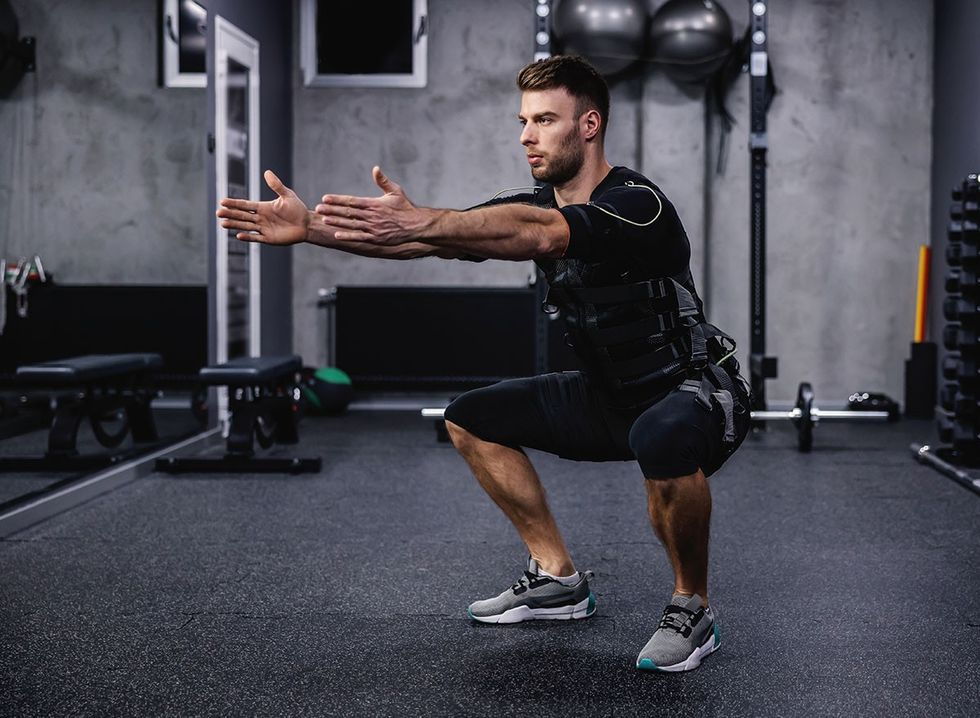When people ask me, as a fitness expert who has worked in the industry for a decade, about the latest and greatest exercise techniques, I turn to the science. And the general scientific consensus in areas that matter to the average gym-goer is pretty similar to what it was a few years ago. Most of the time, claims about an advancement are taken out of context and don’t represent scientific consensus on what’s going on.
There’s only so much you can do with your body, and the crazy stuff doesn’t work. In this spirit, I want to discuss a handful of evidence-based techniques that could help out readers who are probably new to those techniques, and would find them valuable. They're not new, but they are extremely effective, evidence-backed techniques backed by science.
Post-activation Potentiation

This is basically just a way to help you be more explosive. It only indirectly translates to you becoming more explosive long-term, but directly helps you be more explosive immediately after using this technique. Think of it like a special kind of situational warm-up, that helps you perform better on your very next exercise, but doesn’t have benefits that extend much further than that. It’s something that is useful if you’re an athlete who cares about how much power you could produce.
For example, if you care about how high you can jump or fast you can sprint, this could be a helpful tool to use occasionally in your training. It works by neuromuscularly priming your body before performing the exercise you want to be very explosive during. If you perform a set with a 5 rep max load with an exercise, then proceed to perform a set of an explosive exercise that uses similar muscles to the first exercise, then you’ll have greater performance with the second exercise than you normally would.
Because your body recently recruited pretty much all of your muscle fibers for a brief period of time during your 5RM set shortly before your explosive set, it makes it easier for you to recruit more muscle fibers and use those fibers with a higher motor unit rate coding than you otherwise would. This just translates to you producing more force faster for that one set. Long-term it could make you more explosive by virtue of you being more explosive in your training.
Post-Activation Potentiation #1

You can perform a heavy back squat with your 5RM, and then perform a counter movement jump shortly afterwards. The CMJ is explosive and shares agonist muscles with the back squat, such as the gluteus maximus, quadriceps femoris, and many others.
Post-Activation Potentiation #2

You can perform a heavy bench press with your 5RM, and then perform an explosive push up shortly afterwards. The explosive pushup is explosive and shares agonist muscles with the bench press, such as the pectoralis major and anterior deltoid.
Agonist-Antagonist Inhibition

This happens when you train two antagonist muscles back to back. Antagonist muscles are basically ones that have the opposite function of each other. In many cases, but not all, they are on the opposite side of each other on your body. So it can be easy to identify some of them.
The easiest pair to think of are the biceps and triceps. The biceps flex your elbow, and the triceps extend your elbow. Normally, muscles exert passive tension on your joints, which resists the efforts of their antagonist because antagonists pull on your body in the opposite way. In practice this results in you being able to perform less reps because it’s a bit harder to do so.
Agonist-antagonist inhibition, also called reciprocal inhibition, lets you fatigue an antagonist of a muscle so you can get more out of the muscle you’re trying to train. It’s super simple to do. You just train two exercises back to back with minimal rest, that involve opposite muscles. This will be most helpful for the muscle you train second because it’ll most directly benefit from the effects of agonist-antagonist inhibition.
Agonist-Antagonist Inhibition #1

You can perform a set of barbell curls and set of rope tricep extensions back to back. These involve antagonist muscles, so it’ll help you get more out of whichever you use in your second set.
Agonist-Antagonist Inhibition #2

You can perform a set of seated leg extensions and lying hamstring curls back to back. These involve antagonist muscles since one focuses on a muscle that extends your knee and the other focuses on a muscle that flexes your knee.
De-emphasizing Biarticular Muscles

This happens when you position your body in such a way that a muscle that has multiple functions is basically busy engaging with one of those functions, so isn’t very effective at performing its other functions. If a muscle has the ability to flex the knee and extend the hip, but is already flexing the knee, it won’t contribute as much force towards hip extension. This can be useful if you want to isolate a muscle that shares a function with the biarticular muscle.
If two muscles share a function, they usually both contribute to it. So going back to that example: if a second muscle extended the hip too, normally both the second muscle and the first one would contribute a lot of force to hip extension. But, if the first muscle is already shortened because the knee is fully flexed, then hip extension will be much more dependent on the second muscle.
This lets you emphasize the muscle you want a little more. This only works with muscles that contribute to multiple joint actions and won’t work with every muscle combination.
De-Emphasizing Biarticular Muscles #1

You can perform a glute kickback with your knee flexed. This de-emphasizes the role of the hamstrings since they are involved in both hip extension and knee flexion. This means that the role of hip extension then gets shifted more heavily towards your glutes. This can help you build your glutes more easily.
De-emphasizing Biarticular Muscles #2

You can perform a leg raise with your knees extended. This de-emphasizes the role of your hip flexors since your rectus femoris has a role in hip flexion, but also is involved in knee extension. This causes the exercise to shift more focus towards your abs.
Potential Risks and Drawbacks

There aren’t really any major risks with using anything I’d discussed. The most important thing to keep in mind is probably with post-activation potentiation. It’s easy to lose focus when lifting something heavy, if your mind is already moving on to the next thing you’re going to do when the set is over. It’s more common for people’s minds to wander when the whole reason they’re lifting something heavy is to prep them for what they’re about to do in a few moments. It’s important to stay focused on what you’re doing, because injuries happen when you stop paying attention.
RELATED: I’m A Fitness Coach and This Is Perfect Full Body Beginner Workout
Results You Can Expect

A regular person won’t really see anything extreme following any of these techniques. It would be disingenuous to say that you could expect to see a huge change from what you’d see by not using these techniques. However, if used appropriately, you might be able to see a small increase in long-term power following regular post activation potentiation use in your training. The effects of post activation potentiation are interesting since they differ depending on how well trained someone is.
If you’re not that well trained, you won’t see that much of a difference. But, if you’re very well trained, then you will see more of a difference. Athletes in particular may benefit from multiple priming sets, although this would lead to a lot more fatigue in a less well trained population.
You Might Be Able to Squeeze Out an Extra Rep or Two

You might be able to squeeze out an occasional extra rep or two using agonist-antagonist training somewhat regularly. It could lead to a small increase in the amount of muscle you build, but you would still benefit from using regular training techniques as well and not using this technique all the time. You can grow in different ways by relying on this technique vs. other methods, relying just on this technique can only get you so far.
You Might Notice This Difference, Too

When it comes to de-emphasizing biarticular muscles, you will notice a meaningful difference in how much an exercise supports adaptation in the muscle you’re shifting emphasis towards. However, when this is considered in the context of being able to just train that muscle directly anyway through other exercises, the actual net gain will be on the small end. But, everything helps. Just don’t forget to also adequately train the muscle you’re de-emphasizing. Every training tool has a place and this can help you with special goals and in special circumstances.
RELATED: William Li Shows Off His Ribbed Torso and Shares 5 Tips to Naturally Boost Your Testosterone
Final Word From the Trainer

It’s worth keeping in mind that you don’t have to use these techniques all of the time. You shouldn’t use these techniques all of the time. They are tools, like anything else. Use them when they are most appropriate to use. Use them in the context that makes the most sense.
💪🔥Body Booster: Enhance your explosive power by neuromuscular priming. Lift heavy, then quickly follow up with an explosive exercise using the same muscle groups.
Domenic Angelino, MS, CSCS, FNS, CPT, is a Fitness Consultant and Exercise Scientist at Trainer Academy.









 Shutterstock
Shutterstock Shutterstock
Shutterstock Shutterstock
Shutterstock Shutterstock
Shutterstock






 Shutterstock
Shutterstock Shutterstock
Shutterstock Shutterstock
Shutterstock Shutterstock
Shutterstock Shutterstock
Shutterstock Shutterstock
Shutterstock Shutterstock
Shutterstock Shutterstock
Shutterstock Shutterstock
Shutterstock Shutterstock
Shutterstock Shutterstock
Shutterstock Shutterstock
Shutterstock Shutterstock
Shutterstock Shutterstock
Shutterstock Shutterstock
Shutterstock Shutterstock
Shutterstock



 YouTube/OSF HealthCare
YouTube/OSF HealthCare Shutterstock/Pavel_Kostenko
Shutterstock/Pavel_Kostenko Shutterstock/siam.pukkato
Shutterstock/siam.pukkato Shutterstock/Maridav
Shutterstock/Maridav Shutterstock/Andriiii
Shutterstock/Andriiii

 I'm a Nutritionist and These 9 High-Protein Snacks Keep My Clients Full While Losing 50 Pounds
I'm a Nutritionist and These 9 High-Protein Snacks Keep My Clients Full While Losing 50 Pounds
 Shutterstock
Shutterstock 2. Processed FoodsShutterstock
2. Processed FoodsShutterstock Shutterstock
Shutterstock Shutterstock/Prostock-studio
Shutterstock/Prostock-studio Shutterstock
Shutterstock Pro TipsShutterstock
Pro TipsShutterstock Shutterstock
Shutterstock Shutterstock
Shutterstock Shutterstock
Shutterstock Shutterstock
Shutterstock Don’t Drink as Much AlcoholShutterstock
Don’t Drink as Much AlcoholShutterstock Most Women on GLP-1s Are Making a Few Common MistakesShutterstock
Most Women on GLP-1s Are Making a Few Common MistakesShutterstock Soda and Sugary DrinksShutterstock
Soda and Sugary DrinksShutterstock Shutterstock
Shutterstock Eat BreakfastShutterstock
Eat BreakfastShutterstock And Improve Insulin SensitivityShutterstock
And Improve Insulin SensitivityShutterstock Belly Flab Strip Tip: Sugar and Fat Calories Leave Its Mark on Your BodyShutterstock
Belly Flab Strip Tip: Sugar and Fat Calories Leave Its Mark on Your BodyShutterstock Shutterstock
Shutterstock The Drugs Mimic the GLP-1 Hormone Naturally Produced by the BodyShutterstock
The Drugs Mimic the GLP-1 Hormone Naturally Produced by the BodyShutterstock 3. Deep-Fried ItemsShutterstock
3. Deep-Fried ItemsShutterstock